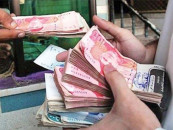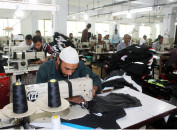Sovereign ratings: Pak-China economic corridor a ‘credit positive’, says Moody’s
Rating agency believes highest investment, growth will help close budget deficit.

The influx of investment into Pakistan is what prompted Moody’s to view the economic corridor as a positive from a credit perspective. PHOTO: AFP
Even though the project had not yet got off the ground, the China-Pakistan Economic Corridor, Moody’s Investor Services – one of the three largest credit rating agencies in the world – has described the project as a ‘credit positive’ for the country, implying that the economic growth generated will eventually help the government’s finances.
“The government’s support for the implementation of the so-called China-Pakistan Economic Corridor (CPEC) is credit positive for Pakistan because it will spur investment activity, boost bilateral trade flows and help ease the country’s growing energy shortages,” Moody’s said in a note issued to clients on Monday, according to a report in the International Business Times.
The $46-billion project would create a 2,000-kilometre road and rail link from China’s western hinterlands to the Gwadar Port, creating a network of infrastructure in Khyber-Pakhtunkhwa and Balochistan to match the one originally built by the British (and expanded by successive Pakistani governments) in Punjab and Sindh.
Moody’s has the lowest rating for Pakistan, at Caa1, just two grades above default. The rating implies that Pakistan is dependent on favourable economic conditions to be able to pay its obligations. Standard & Poor’s – a rival credit rating agency – has a rating of B, two notches above the Moody’s rating. Fitch, the third credit rating agency, does not have a current credit rating for Pakistan. Both Standard & Poor’s and Moody’s have a stable outlook for Pakistan.
The influx of investment into Pakistan is what prompted Moody’s to view the economic corridor as a positive from a credit perspective. The credit rating agency uses several macroeconomic indicators to determine its rating for Pakistan’s government, including investment as a percentage of the total size of the economy.
Pakistan’s investment-to-GDP ratio is 14.6%, far lower than the median of 22.9% for countries with a B-rating, said Moody’s.
Another reason Moody’s believes this project will be positive for Pakistan is their belief that Islamabad will be able to get Beijing to finance several energy projects throughout the country that would reduce the cost of power generation, ultimately lowering the need for electricity subsidies – a key burden on the federal budget – and improving economic growth, which would in turn increase tax revenues for the government. Those two effects combined could substantially reduce the budget deficit.
The rating agency acknowledged that much of the project’s key benefits would not materialise until 2017, but stated that it believes at least some of the benefits from the economic corridor would likely begin accruing even before then.
While China is Pakistan’s largest trading partner, foreign investment from China has historically been relatively low. Over the past decade, more than a quarter of the $30 billion in foreign investment into Pakistan has come from the United States, with China’s investment being among the lowest from larger economies. However, over the last year, China was Pakistan’s largest foreign investor.
The project has run into some snags in the Senate, with lawmakers from Khyber-Pakhtunkhwa and Balochistan alleging that the Nawaz administration is redirecting the route of the corridor to pass through Punjab and Sindh rather than their provinces. In addition, Beijing has balked at funding projects that are not directly related to connecting its economically deprived western regions to Gwadar Port.
Published in The Express Tribune, March 3rd, 2015.
Like Business on Facebook, follow @TribuneBiz on Twitter to stay informed and join in the conversation.



















COMMENTS
Comments are moderated and generally will be posted if they are on-topic and not abusive.
For more information, please see our Comments FAQ